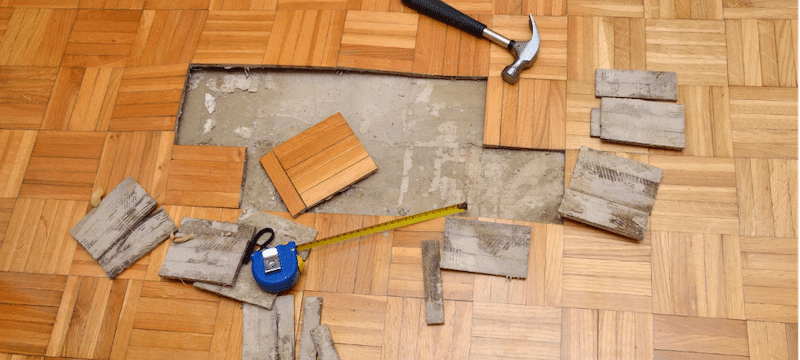Wood floors look luxurious and beautiful, until they’re under a foot of standing water. Many a homeowner has dealt with floodwaters and wood floors, with heavy hearts.
Whether you’re dealing with heavy rains that cause floods or just a plumbing disaster, flood water damage is costly. If you have wood floors, it will cost you even more.
However, there is a solution. You can fix your water-covered floor if you act quickly and follow some basic steps. Below is a step-by-step guide on how to fix water-damaged wood floors.
Respond Immediately
As soon as you can, begin mopping up the water that is causing your wood floor damage. Use a shop vacuum to remove as much water as you can from the surface of your wood floor.
Make sure you put the shop vacuum on wet mode and then start sucking up your excess water. Have someone squeegee the water to push it in one place as you vacuum it up.
You can save yourself a lot of water damage repair costs if you can remove the water early on. As water sits on your wood floor, your likelihood of a swollen wood floor and other damage greatly increases.
Check With Insurance
If you live in an area prone to flooding, stay up to date on flood coverage. Federal and private insurance policies change regularly, so know your policy. You may not even have flood coverage, even if you live in an area prone to water problems.
Call your insurance agent to see what your insurance will cover. It could cover replacing the floor. If it does not, see if it will cover the cost of having an expert in floor restoration do your work for you.
You can mitigate your water damage floor repair cost with one simple call. At least you’ll know how much work you have to do and how much money you can expect to pay to fix the problem.
You can mitigate the damage yourself with a few basic steps, but a floor restoration expert will have more tools and know-how to fix the job.
Clean the Floor
Once you’ve removed the water, you need to remove all of the silt and other contaminants that could cause mold growth. Mix a floor detergent with a mild detergent and clean water. Then scrub your entire floor and all of the wood connecting to it.
Do not forget your baseboards, banisters, and stairs.
Use a stiff brush to scrub the wood thoroughly and bring up the contaminants that may have worked their way into the wood. Rinse your brush in the bucket regularly.
Scrubbing will take some work. Avoid the temptation to just dump your soapy water on the floor and scrub it in. Do not add more water to your floor.
Instead, focus on bringing up the natural materials that were in the floodwater. These materials can promote mold growth and cause problems in time.
Attack Mold
If mold has already taken hold on your floor, attack it with a vengeance.
Use TSP (trisodium phosphate) or a TSP substitute and water to combat your mold. You can find TSP at any local hardware or retail store.
Mix the solution according to the manufacturer’s directions and scrub the mold areas until the mold and its discoloration have disappeared. Rinse the area with clean water and dry it with an absorbent cloth.
TSP has effective but caustic chemicals, so use it with caution. You can also use a natural TSP substitute to avoid the problems that TSP carries with it.
Ventilate the Area
Once you’ve scrubbed the floor and removed the mold, ventilate the area. You need to let the floor air dry. You can facilitate the process by creating as much airflow as possible.
Open the windows, use box fans and industrial fans, and create as much airflow as possible to dry out the wood floor. If you have a box fan, put it in an open window or doorway and have it blowing out of the room. This will create the airflow you need to dry the room and remove the humidity.
Do not attempt to dry out the room with heat. Wood floors need to dry slowly and naturally. When you introduce heat to the room, the wood may dry so quickly that it cracks.
Deal With Cupping
Wood may warp or cup after floor waters have soaked it through. If your dry wood floor is beginning to show signs of cupping, you can sand the floor down to smooth it out.
If the end boards begin to curl up, use face nails to nail the wood back down. You may end up having to replace a plank or two in this process.
If you have a painted floor, you may end up having mold under the paint. Paint will trap moisture, leaving ideal conditions for mold to grow.
Thus, you will need to remove the paint. Strip your boards by sanding them down. Then scrub the area with TSP or a TSP substitute and paint it again.
Replace Your Laminate
Laminate flooring looks like a natural wood floor. However, it consists of wood pulp similar to pressboard. As a result, it will not dry properly, and you will have to replace it.
Water-damaged laminate flooring needs replacing rather than refacing. Again, contact your insurance company to see if they will cover the cost of replacing a laminate floor. This will cost much less than replacing a hardwood floor.
Manage Flood Water Damage
Do not despair over water and wood. Yes, flood water damage costs money and takes time and money to fix. If you have flood insurance or homeowner’s insurance that covers water damage, you have an out.
Are you looking for a new insurance provider? Contact us. We can give you a quote and let you know what coverage we have available for you.
LEGAL DISCLAIMER
Views expressed here do not constitute legal advice. The information contained herein is for general guidance of matter only and not for the purpose of providing legal advice. Discussion of insurance policy language is descriptive only. Every policy has different policy language. Coverage afforded under any insurance policy issued is subject to individual policy terms and conditions. Please refer to your policy for the actual language.




